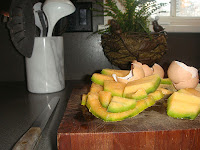Indoor Composting
By Clifford WoodsComposting can be termed as the conversion of waste in to usable fertilizer. It is largely a natural phenomenon in which the decomposition of the waste materials happens under the presence of oxygen. The large particles of waste are broken down in to finer pieces by the action of bacteria, worms, fungi, air and heat.
Besides the natural phenomenon of composting, people can prepare compost at home as well through indoor composting. This method of composting is easy to manage and can be carried out with the waste collected from a garden.
Making compost at home is a very simple an easy process that does not require much effort or resources. All one needs for making it at home is a barrel or a pot in which the waste materials like dried grass and leaves are stored away. When this waste is subjected to water and oxygen, the waste starts decomposing and turning in to compost. Another way of turning the waste collected in the barrel is to expose it to heat and moisture. Under the action of sunlight and the water vapors, the waste breaks down and turns in to nutrient-rich fertilizer.

There are many benefits of composting. The first major benefit that composting has is that it recycles the waste products in to something useful. By converting the wasted materials into fertilizer and indoor composting can do this too, a household not only is disposing off their waste, but is also in creating something useful from it.
The conversion of waste into useful products is good for the environment as well as it lessens the amount of land pollution and keeps the earth garbage free. Thus, composting is beneficial not only for the people but also for maintaining the ecological system of our planet too.
Compost, also known as humus, is great for growing plants and can help reduce the use of artificial fertilizer in gardening. Since compost is made from organic materials, it is rich in nutrients that are required by the plants and at the same time is not at all harmful for the soil.
On the other hand, the artificial fertilizer used to make the plants grow faster is extremely hazardous for the soil and can damage its growth potential. By having compost made by indoor composting you then replace the artificial fertilizer for your indoor plants. A person will not only be saving himself from spending extra money on the purchase of the fertilizer but will also help in saving the soil’s potential too.
Another of the benefits of composting that you can get is that it helps in controlling erosion. In areas that get a lot of rainfall, top soil loss and erosion is a major problem. In such areas, the use of compost whether manufactured through indoor composting or natural means can help in providing a solution to this problem.
Since compost has a high water-retaining capacity, it soaks up the water and seeps it in to the soil without letting the water erode the soil. This way compost can help in saving the top soil and prevent soil erosion, which is among the most serious ecological issue the world is facing today.
Beneficial Microorganisms are very useful when one is engaging in indoor composting. What these microorganisms do is speed up the composting process by as much as half the time or more and they also eliminate any odors that naturally accompany the composting process.
Indoor Composting with the use of beneficial microorganisms will get the job done faster with no odors.
Because of all these benefits, making compost through indoor composting is a healthy activity that can help not only your garden but can also aid the environment by reducing land pollution. This article offers some benefits and uses of composting, indoor composting and the general value of engaging in composting as an activity to help the environment._ _ _ _ _ _ _ _ _ _ _
At Effective Environmental Services we brew Beneficial Microorganisms and offer Environmentally Friendly Products - including the Indoor Magic Bokashi Composting System.